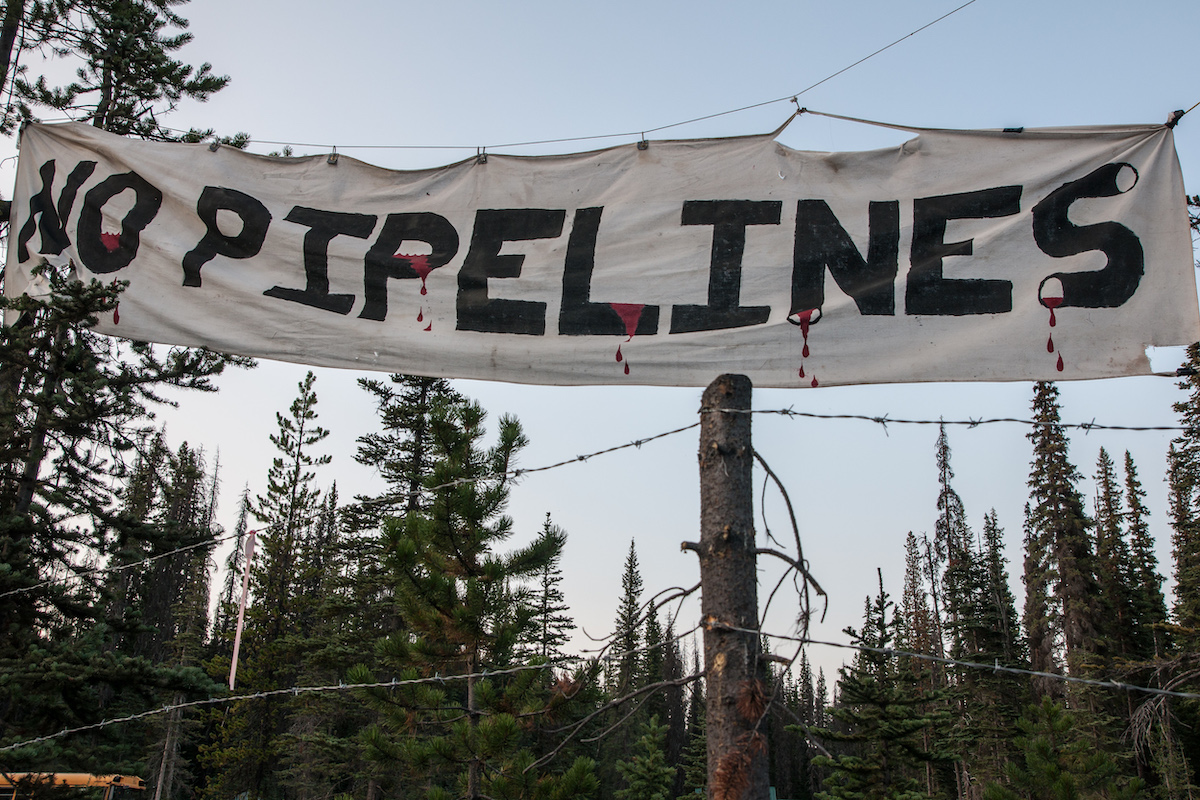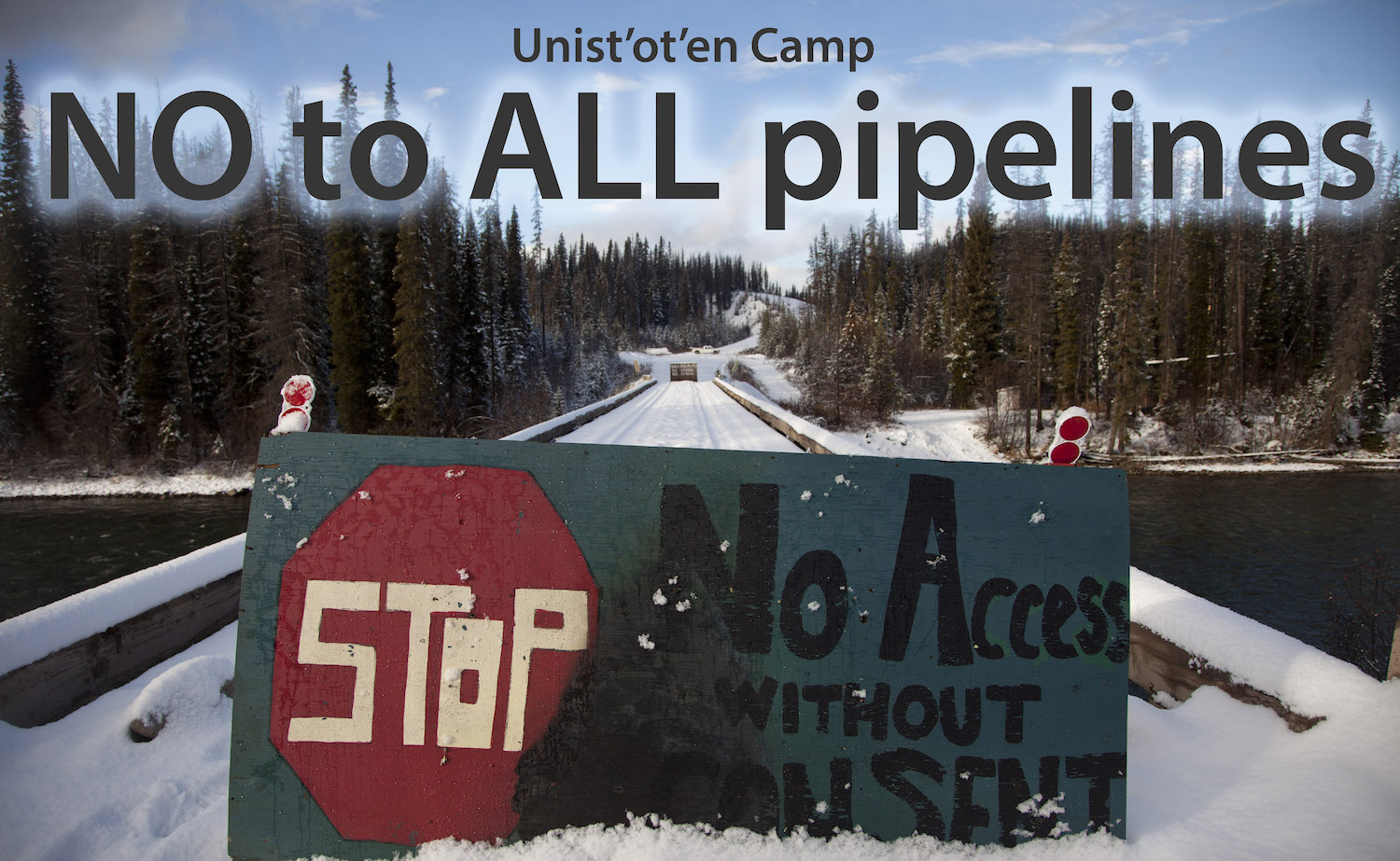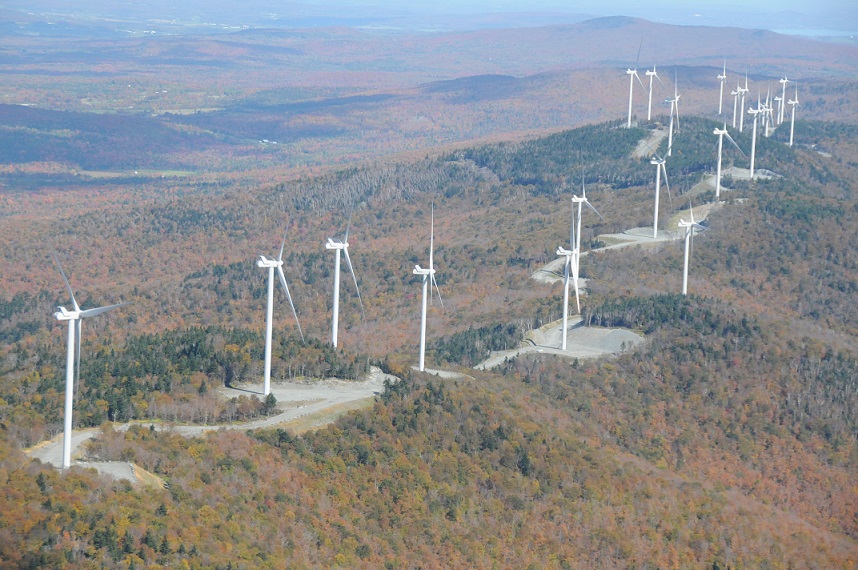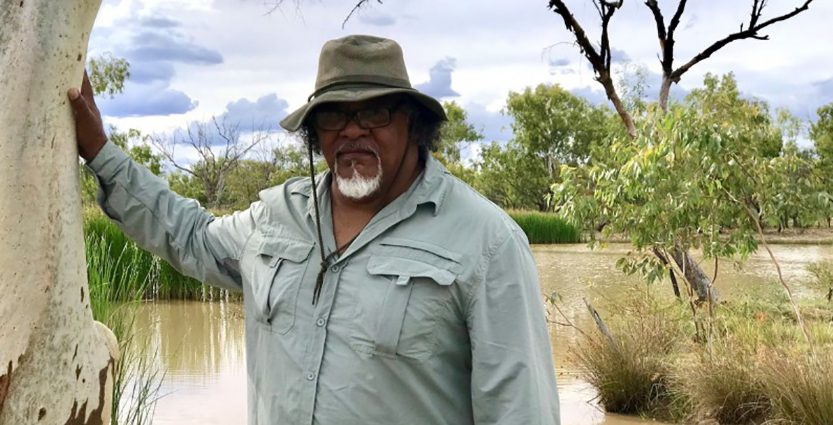
by DGR News Service | Jan 10, 2019 | Indigenous Autonomy
Today the Coastal Gaslink company will be negotiating with the Wet’suwet’en traditional leadership. They may potentially allow workers past the barrier at Unist’ot’en Camp to conduct “pre-construction” activities.
However, the compliance with the temporary injunction is not a surrender on the part of the Wet’suwet’en. It was a tactical maneuver to gain advantage in the short term and prevent physical harm to members of the nation. The camp stands and the nation has no intention of allowing the pipeline to be built.
They aim to continue the fight. A legal battle may be brewing that could end up in the Canadian Supreme Court. It is possible physical confrontations will continue in the future as well. The Unist’ot’en have already defeated 6 of the 7 proposed pipelines across their land and do not mean to let this final pipeline be built.
From the Unist’ot’en Camp website:
WAYS TO SUPPORT:
We are are humbled by the outpouring of solidarity and support for our Wet’suwet’en people. We expect RCMP aggression at any time. We are still fundraising for our legal battle in the colonial courts. Please donate.
 DONATE to Unist’ot’en Camp Legal Fund
DONATE to Unist’ot’en Camp Legal Fund
 DONATE to Gidimt’en Access Point
DONATE to Gidimt’en Access Point
 COME TO CAMP: Supporters in the local area wanting to do something should head to KM 27 now. Meet at the junction of Morice River Road and Morice West where people are gathering to plan additional responses to this incursion.
COME TO CAMP: Supporters in the local area wanting to do something should head to KM 27 now. Meet at the junction of Morice River Road and Morice West where people are gathering to plan additional responses to this incursion.
 HOST A SOLIDARITY EVENT: See the International Solidarity with Wet’suwet’en event page. We are conducting peaceful actions as sovereign peoples on our territories, and ask that all actions taken in solidarity are conducted peacefully and according to the traditional laws of other Indigenous Nations. Forcible trespass onto Wet’suwet’en territories and the removal of Indigenous peoples from their lands must be stopped. Provincial and federal governments must be confronted.
HOST A SOLIDARITY EVENT: See the International Solidarity with Wet’suwet’en event page. We are conducting peaceful actions as sovereign peoples on our territories, and ask that all actions taken in solidarity are conducted peacefully and according to the traditional laws of other Indigenous Nations. Forcible trespass onto Wet’suwet’en territories and the removal of Indigenous peoples from their lands must be stopped. Provincial and federal governments must be confronted.
 SIGN THE PLEDGE: Join thousands of organizations and individuals in signing the pledge in support of Unist’ot’en
SIGN THE PLEDGE: Join thousands of organizations and individuals in signing the pledge in support of Unist’ot’en

by DGR News Service | Jan 9, 2019 | Colonialism & Conquest, Indigenous Autonomy
On Monday, January 7th, Canadian federal police raided the Wet’suwet’en Access Point on Gidumt’en Territory on unceded indigenous land in what is commonly known as British Columbia, Canada.
The Access Point is the forward position of a pipeline occupation held primarily by the Unist’ot’en Clan of the Wet’suwet’en First Nation. The Unist’ot’en have been occupying this part of their territory for nine years to block numerous oil and gas pipelines from destroying their territory.
On Wednesday afternoon, the RCMP lifted the roadblock and exclusion zone that had been in place since Monday morning. Several RCMP negotiators, as well as hereditary chiefs, passed through the barrier on the bridge over the Wedzin Kwah and are currently engaged in negotiations inside the healing center.
The latest reports confirm that the Unist’ot’en will comply with the injunction and allow some Coastal Gaslink employees onto the territory. It remains to be seen what form the struggle will take.
Fourteen land defenders were arrested on Monday including spokesperson Molly Wickham. She describes what happened in this video. All of the arrestees have been released as of 3pm Wednesday. You can donate to the legal support fund here.
Molly Wickham, Gitdimt’en spokesperson provides a detailed account of the police raid and arrests.
Media may use clips from this video ensuring context is maintained. Thank you all for your ongoing coverage.
Posted by Wet’suwet’en Access Point on Gidumt’en Territory on Tuesday, January 8, 2019
The RCMP attack is also described in this StarMetro Vancouver article:
After a lengthy, increasingly heated back-and-forth between the demonstrators and police, officers began cutting the barbed wire and started up a chainsaw. Camp members began to scream in protest; two young men had chained themselves to the fence below the view of the officers, encasing their arms in a kind of pipe that meant opening the gate risked breaking both of their arms… [the] checkpoint camp was abandoned behind a massive fallen tree and a barrier of flame on Monday afternoon as dozens of RCMP officers finally pushed past the barricade set up to bar entry to the traditional territories of the Wet’suwet’en people.
The Gidumt’en and Unist’ot’en are two of five clans that make up the Wet’suwet’en Nation. The traditional leadership of all five clans oppose the pipeline. However, the elected band council (a colonial leadership structure set up by the Canadian state) voted in favor of the pipeline.
More than 60 solidarity events took place across Canada and the world this week. Using the hashtag #ShutdownCanada, blockades have stopped major intersections, financial districts, bridges, and ports in Vancouver, Ottowa, Toronto, Victoria, Montreal, and elsewhere.
This situation has a long background and highly significant legal significance. Kai Nagata describes the situation:
Many Canadians have heard of the 1997 Delgamuukw decision by the Supreme Court of Canada, which recognized that Aboriginal title still exists in places where Indigenous nations have never signed a treaty with the Crown. In fact, the court was talking about the land where tonight’s raid is taking place.
Delgamuukw is a chief’s name in the neighbouring Gitxsan Nation, passed down through the generations. Delgamuukw was one of dozens of plaintiffs in the case, comprising hereditary chiefs from both the Gitxsan and Wet’suwet’en Nations.
Together those leaders achieved an extraordinary milestone in forcing the Canadian courts to affirm the legitimacy of their oral histories, traditional laws and continuing governance of their lands. But it wasn’t until the Tsilhqot’in decision in 2014 that the Supreme Court went a step further, recognizing Aboriginal title over a specific piece of land.
If the Wet’suwet’en chiefs went back to court all these years later, many legal scholars say the strength of their claim to their territories would eventually force the Canadian government to relinquish thousands of square kilometres within the Bulkley and Skeena watersheds – and stop calling it “Crown land”.
That’s why the TransCanada pipeline company acted quickly, to secure an injunction against Wet’suwet’en members blocking construction before the legal ground could shift under their Coastal Gaslink project.
The 670-kilometre pipeline project would link the fracking fields of Northeastern B.C. with a huge liquid gas export terminal proposed for Kitimat. Called LNG Canada, this project is made up of oil and gas companies from China, Japan, Korea and Malaysia, along with Royal Dutch Shell.
The BC Liberal, BC NDP and federal governments all courted the LNG Canada project, offering tax breaks, cheap electricity, tariff exemptions and other incentives to convince the consortium to build in B.C. Both Christy Clark and Premier John Horgan celebrated LNG Canada’s final investment decision last fall, calling it a big win for the province.
However, without a four foot diameter (122cm) pipeline feeding fracked gas to the marine terminal, the LNG Canada project is a non-starter.
That brings us back to the Morice River, or Wedzin Kwa in the Wet’suwet’en language. This is where the rubber hits the road for “reconciliation”. Politicians are fond of using the word, but seemingly uncomfortable with its implications.
Politicians also talk a lot about the UN Declaration on the Rights of Indigenous People, and how to enshrine it in B.C. law. Article 10 of UNDRIP states that “Indigenous peoples shall not be forcibly removed from their lands or territories.” It is hard to see how tonight’s arrests are consistent with this basic right.
Pro-pipeline pundits are already working hard to spin this raid as the “rule of law” being asserted over the objections of “protestors”. They point to benefit agreements signed between TransCanada and many band governments along the pipeline route.
But under the Indian Act, elected councillors only have jurisdiction over reserve lands – the tiny parcels set aside for First Nations communities that are administered much like municipalities. That’s not where this pipeline would go.
What is at stake in the larger battle over Indigenous rights and title are the vast territories claimed by the Crown but never paid for, conquered or acquired by treaty. In Wet’suwet’en territory, those lands, lakes and rivers are stewarded by the hereditary chiefs under a governance system that predates the founding of Canada.

by Deep Green Resistance News Service | Aug 27, 2018 | Biodiversity & Habitat Destruction
by Suzanna Jones / Counterpunch
Walden, Vermont–In his 2008 book Deep Economy, Bill McKibben concludes that economic growth is the source of the ecological crises we face today. He explains that when the economy grows larger than necessary to meet our basic needs – when it grows for the sake of growth, automatically striving for “more” – its social and environmental costs greatly outweigh any benefits it may provide.
Unfortunately, McKibben seems to have forgotten what he so passionately argued just five years ago. Today he is an advocate of industrial wind turbines on our ridgelines: he wants to industrialize our last wild spaces to feed the very economy he fingered as the source of our environmental problems.
His key assumption is that industrial wind power displaces the use of coal and oil, and therefore helps limit climate change. But since 2000, wind facilities with a total capacity equivalent to 350 coal-fired power plants have been installed worldwide, and today there are more – not fewer – coal-fired power plants operating. (In Vermont, the sale of Renewable Energy Credits to out-of-state utilities enables them to avoid mandates to reduce their fossil fuel dependency, meaning that there is no net reduction in greenhouse gas emissions.) At best, industrial wind simply adds more energy to the global supply. And what for? More! More energy than the grid can carry, more idiotic water parks, more snowmaking, more electronic gadgets, more money for corporations.
Why should we spend millions of dollars to destroy wildlife habitat, kill bats and eagles, pollute our headwaters, fill valuable wetlands, polarize our communities, make people sick, mine rare earth metals – just to ensure that we can consume as much or more next year than we did this year?
The costs of industrial wind far outweigh the benefits… unless you are a wind developer. Federal production tax credits and other subsidies have fostered a gold rush mentality among wind developers, who have been abetted by political and environmental leaders who want to appear “green” without challenging the underlying causes of our crises. Meanwhile, average Vermonters find themselves without any ability to protect their communities or the ecosystems of which they are part. The goal of an industrial wind moratorium is to stop the gold rush so we can have an honest discussion on these issues. Why does this frighten proponents of big wind? Because once carefully examined, industrial wind will be exposed for the scam that it is.
McKibben’s current attitude towards the environment has been adopted by politicians, corporations, and the big environmental organizations. Environmentalism has been successfully mainstreamed, at the cost of its soul. This co-opted version isn’t about protecting the landbase from the ever-expanding empire of humans. It’s about sustaining the comfort levels we feel entitled to without exhausting the resources required. It is entirely human-centered and hollow, and it serves corporate capitalism well.
In Deep Economy, McKibben points out that the additional “stuff” provided by an ever-growing economy doesn’t leave people happier; instead, the source of authentic happiness is a healthy connection to nature and community. As Vermonters have already discovered, industrial wind destroys both.
What industrial wind represents should be obvious to everyone: this is business-as-usual disguised as concern for the Earth. Far from genuine “environmentalism”, it is the same profit- and growth-driven destruction that is at the root of every ecological crisis we face.
Suzanna Jones is an off-the-grid farmer living in Walden. She was among those arrested protesting the Lowell wind project in 2011.

by Deep Green Resistance News Service | Aug 20, 2018 | Lobbying
Featured image: Wangan and Jagalingou cultural leader Adrian Burragubba visits Doongmabulla Springs in Australia. The Wangan and Jagalingou are fighting a proposed coal mine that would likely destroy the springs, which are sacred to the Indigenous Australian group.
by Noni Austin / Ecowatch
For tens of thousands of years, the Wangan and Jagalingou people have lived in the flat arid lands of central Queensland, Australia. But now they are fighting for their very existence. Earlier this month, they took their fight to the United Nations after years of Australia’s failure to protect their fundamental human rights.
A company called Adani Mining Pty Ltd, part of the Adani Group of companies founded by an Indian billionaire named Gautam Adani, is determined to build the massive Carmichael Coal Mine and Rail Project on the Wangan and Jagalingou’s ancestral homelands. If built, the Carmichael Coal Mine would be among the largest coal mines in the world, with six open-cut pits and five underground mines, as well as associated infrastructure like rail lines, waste rock dumps and an airstrip.
Coals mine are immensely destructive: The Carmichael mine would permanently destroy vast areas of the Wangan and Jagalingou’s ancestral homelands and waters, and everything on and in them—sacred sites, totems, plants and animals. It would also likely destroy the Wangan and Jagalingou’s most sacred site, Doongmabulla Springs, an oasis in the midst of a dry land. The development of the mine would also result in the permanent extinguishment under Australian law of the Wangan and Jagalingou’s rights in a part of their ancestral homelands.
The Wangan and Jagalingou’s lands and waters embody their culture and are the living source of their customs, laws and spiritual beliefs. Their spiritual ancestors—including the Mundunjudra (Rainbow Serpent), who travelled through Doongmabulla Springs to shape the land—live on their lands.
As Wangan and Jagalingou authorized spokesperson and cultural leader Adrian Burragubba said, “Our land is our life. It is the place we come from, and it is who we are. Plants, animals and waterholes all have a special place in our land and culture and are connected to it.”
Consequently, the destruction of the Wangan and Jagalingou’s lands and waters is the destruction of their culture. If their lands are destroyed, they will be unable to pass their culture on to their children and grandchildren, and their identity as Wangan and Jagalingou will be erased.
Murrawah Johnson, authorised youth spokesperson of the Wangan and Jagalingou, said, “In our tribe, women teach our stories to our young people. I want my children and their children to know who they are. And if this mine proceeds and destroys our land and waters, and with it our culture, our future generations will not know who they are. Our people and our culture have survived for thousands of years, and I cannot allow the Carmichael mine to destroy us. I will not allow myself to be the link in the chain that breaks.”
The Wangan and Jagalingou have consistently and vehemently opposed the Carmichael mine, rejecting an agreement with Adani Mining on four occasions since 2012. Throughout its dealings with the Wangan and Jagalingou, Adani Mining has used the coercive power of Australian legislation and acted in bad faith, holding fraudulent meetings and manipulating the Wangan and Jagalingou’s internal decision-making processes.
In these circumstances, the development of the Carmichael mine violates the Wangan and Jagalingou’s internationally protected human rights, including the right to continue practicing their culture and to use and control their ancestral homelands, as well as the right to be consulted in good faith and to give or withhold their consent to mining projects on their lands.
Despite the Wangan and Jagalingou’s persistent objections and their pleas to the Australian and Queensland governments to protect their human rights, both governments have approved the mine and publicly support it, and Adani Mining remains steadfastly determined to develop the project as soon as possible. The Wangan and Jagalingou have also brought litigation in Australia to protect their homelands, but have been unsuccessful to date because Australian law allows private companies and the government to override the Wangan and Jagalingou’s rights in their ancestral lands.
Now, to protect their fundamental human rights, the Wangan and Jagalingou have been forced to seek help from a United Nations human rights watchdog. Recently, the Wangan and Jagalingou asked the UN Committee on the Elimination of Racial Discrimination to urgently ensure Australia protects their homelands and culture. The committee is the enforcement body of the UN Convention on the Elimination of All Forms of Racial Discrimination, a treaty Australia has signed. The convention is one of the core international treaties among the world’s nations that protect our most basic human rights, including Indigenous peoples’ rights to culture and land.
If Australia will not listen to its own people, the Wangan and Jagalingou hope it will listen to international community and cease prioritizing the profits of a foreign company over the permanent loss of a people who have been connected to the land since time immemorial.
Earthjustice assisted the Wangan and Jagalingou to prepare their request for urgent action to the UN.

by Deep Green Resistance News Service | Jul 11, 2018 | Mining & Drilling, NEWS
by Center for Biological Diversity
SALT LAKE CITY— Conservation groups today formally opposed the Trump administration’s plan to facilitate the first commercial oil shale development in the United States, a massive Utah project that would generate enormous greenhouse gas and deadly ozone pollution in regions already exceeding federal air-pollution standards.
The Bureau of Land Management plans to grant the Estonia-owned Enefit American Oil rights of way to build water, gas, electric and oil-product lines to its 13,000-acre strip-mining “South Project” on private land. In total Enefit has 30,000 acres of private, state and public-land leases in the Uintah Basin. The land contains an estimated 2.6 billion barrels of kerogen oil, and its extraction would require pumping billions of gallons from the Colorado River Basin.
“This plan would turn plateaus into strip mines, pull precious water from our rivers, and cause dangerous climate and ozone pollution. It’s everything the Colorado River Basin doesn’t need,” said John Weisheit, a river guide and the conservation director of Living Rivers. “The BLM should dump this plan and stop wasting time and money by propping up Enefit’s wild speculation.”
“The Colorado River Basin is in crisis thanks to water shortages caused by overallocation, mismanagement, and devastating climate change,” said Daniel E. Estrin, advocacy director at Waterkeeper Alliance. “Enabling development of one of the most carbon and water-intensive dirty fuel projects in the nation in the Upper Colorado River Basin will only exacerbate the decline of our waterways and our climate.”
The South Project would produce 547 million barrels of oil over three decades, spewing more than 200 million tons of greenhouse gas — as much as 50 coal-fired power plants in a year. The amount of energy it takes to mine and process oil shale make it one of the most carbon-intensive fossil fuels on Earth.
“This project would be a climate and health disaster,” said Taylor McKinnon of the Center for Biological Diversity. “The last thing the Colorado River Basin needs is a new fossil fuel industry warming the climate, sucking rivers dry and choking communities with more deadly ozone pollution.”
The BLM refused to look at the air, climate and other potential damage from the development, claiming that Enefit would build the project even without the rights of way. But in fact Enefit would be financially and technically unable to build the project otherwise. Ignoring the development’s potential environmental damage violates the National Environmental Policy Act.
“Oil shale is a dirty fuel that does not deserve a foothold on our public lands,” said Alex Hardee, associate attorney at Earthjustice. “BLM’s action will facilitate depletion of the Upper Colorado River watershed, increased smog pollution in the Uinta Basin, the destruction of wildlife habitat, and substantial greenhouse gas emissions.”
“Without BLM’s approval of rights-of-way across public lands, Enefit would need to truck water, natural gas, and processed oil—more than one truck every 80 seconds for 30 years,” said Grand Canyon Trust staff attorney Michael Toll. “Without this federal subsidy, it’s unlikely Enefit could afford to move forward. Why should Americans subsidize an otherwise unfeasible oil shale project, especially when BLM has yet to comply with the National Environmental Policy Act’s mandate to fully analyze and inform the public of the impacts of Enefit’s proposed project?”
The project would double oil production in the Uintah Basin and refine that oil near Salt Lake City, worsening ozone pollution in both areas. In May the Environmental Protection Agency determined that air pollution in the Uintah Basin and Salt Lake City exceeds federal health standards.
“The Uinta Basin suffers from some of the worst air quality in the nation,” said Landon Newell, a staff attorney with the Southern Utah Wilderness Alliance. “BLM’s kowtowing to the fossil fuel industry is largely to blame for the current crisis and its approval of this energy intensive, environmentally destructive, boondoggle of a project will only worsen the problem.”
“A pollution crisis will inevitably lead to a public health crisis, and there is preliminary evidence that one may already be occurring with high rates of perinatal deaths in the Uinta Basin,” said Dr. Brian Moench, board president of Utah Physicians for a Healthy Environment. “The health risks go well beyond ozone and particulate pollution. Although VOCs are not addressed by EPA national standards, they likely represent the greatest toxicity to the population, especially for infants and pregnant mothers.”
“The last thing we need is an Estonian oil company using Americans’ public land to prop up destructive oil shale mining. Yet the Trump Administration’s BLM failed to give this dirty energy subsidy the hard look it demands,” said Jacob Eisenberg of the Natural Resources Defense Council. “Enefit is a company with an extraordinarily dubious environmental track record; NRDC opposes its proposal for the harm it could do to our natural heritage, climate, and public health.”
Enefit’s oil-shale operation would draw more than 100 billion gallons of water from the Colorado River Basin over the next three decades, threatening endangered fish recovery and exacerbating flow declines in the Green and Colorado rivers downstream. The project would also generate more than 450 million cubic feet of waste rock every year, much of it toxic.
“Now is the time to accelerate the transition to clean energy, not to sacrifice our water, air quality, and climate for an investment in one of the dirtiest fossil fuels on the planet,” said Sierra Club beyond dirty fuels associate director Cathy Collentine. “The Sierra Club and our allies will continue to fight to ensure that this dirty mining project never goes forward.”
The BLM is moving forward with this development even as the Colorado River Basin suffers climate-driven river flow declines, record droughts and wildfires.
Photo by Darla Hueske on Unsplash













